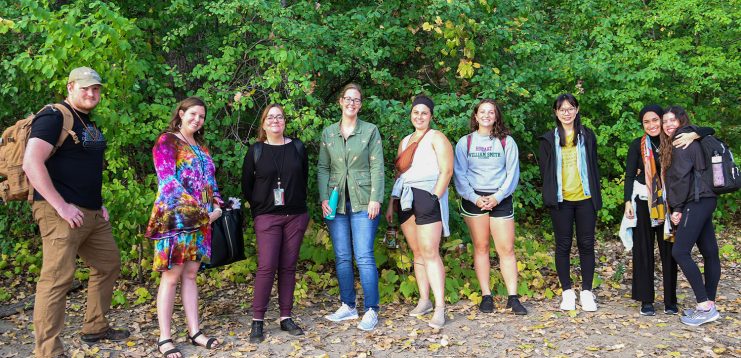By Allison Campbell-Jensen

Recently, Outreach Librarian Kristen Mastel led a group in a forest bathing session, an activity that arose in Japan during the 1980s as a way to combat workplace stress.
Forest bathing, also known as shinrin-yoku, arose in Japan during the 1980s as a way to combat workplace stress, Kristen Mastel told her workshop participants. People worked long hours and “they were being consumed by stress,” she said.
“Many find nature as a calming presence; in Japan, they actually prescribe it.”
The Japanese have taken before and after measures of blood pressure and other health metrics as evidence of the benefits of forest bathing. Recently, Mastel led a group in a forest bathing session. The group included students from the Humphrey master of development practice program, physical therapy, and rehabilitation medicine, staff from the Center for Spirituality and Healing, an exchange student from Taiwan, and others.
Mastel explains her leadership of the workshop as a way to help students.
“As an outreach and instruction librarian with a background in nature-based therapy, I am always looking for ways to incorporate nature into academia, either through assignments or outreach opportunities,” she says. “Seeing mental health hitting a crisis point amongst students, I have experienced and seen how nature not only can de-stress but heal. Forest bathing is just one activity which might help students reconnect with nature, to reconnect with themselves, to slow down and practice self-care.”
By offering forest bathing experiences, Mastel adds, she hopes to show the community some exercises that they can then practice on their own for their physical, mental, emotional, and spiritual wellbeing.
The Oct. 7 group met in the Toaster and then walked from Walter Library down to the East River Flats Park.
Under the trees
“I have experienced and seen how nature not only can de-stress but heal. Forest bathing is just one activity which might help students reconnect with nature, to reconnect with themselves, to slow down and practice self-care.”
—Kristen Mastel
“This is like a great hammock spot,” one student suggested to another arriving under a knot of trees. Then the group gathered in a circle and shared some of their treasured experiences of nature.
Mastel mentioned the Oberg hiking trail near Lutsen, from which one can see trees and ponds and Lake Superior. Another talked about Itasca State Park, where a trail not on the map led to a big boulder dropped by a glacier. A nature preserve in Richfield; a natural spring; pausing for sunset each night while on the Mediterranean Sea; the view from a village in Mongolia, from a small hill straight to the horizon: “the bluest sky.” A bench in this park; Duluth “where anywhere was close to nature”; and a park in the middle of Pittsburgh — “it tells your brain it’s time to tune in.”
Then Mastel asked the group to root themselves, sitting or standing, in the ground with eyes closed.
“You might notice the wind against your clothes, your hair, your skin,” she suggested. Continuing the meditation, she asked them to focus on hearing: “What’s the furthest thing you can hear? . . . What can you hear close by? Are the trees telling you things?”
Then she asked participants to put their hands on their hearts and turn slowly in a circle, to find where they were led.
One saw colors in the tree bark; another was struck by hearing voices — “hearing is not a sense I use much”; and another said, “I finally realized it smells like fall.” It reminded her of sitting among the autumn leaves as a child: “I haven’t had that for a while.”
Viewing the rain garden
Next, the group walked over to a rain garden, where Mastel asked them to walk slowly and take in as many colors as possible. One spotted fluorescent green veins in the plant leaves; another noticed the transition from summer to fall in the garden; a third said, “I noticed being in the moment — not waiting for my phone alerts.” Another noticed the clouds; more than one person took in bees feeding on aster blossoms.
In the training she received in Japan eight years ago and with the Forest Therapy Hub, Mastel learned to forage to make a tea for a tea ceremony as a finale for the forest bathing. The rain garden might have been a good source for plants for a homemade tea but because of COVID, she is not doing that part of the experience for now. And she noted that the participants should never forage on their own unless they know what the plants are.
Down to the riverside
Leading the group to a sandy shore of the Mississippi River, Mastel asked them to observe the water, movement, and how an object interacts with the water by throwing a stone or a stick. A flock of Canada Geese flew overhead and the sun peeked through the clouds as the group took in the river, which was flowing south but had its surface ruffled by northerly winds.
Mastel gave the shore a drink from her water bottle and then asked what people were feeling.
“It’s important to find spaces like this to breathe.”
“It’s really peaceful.”
“As it gets colder, I always stay inside, but getting outside is so helpful” that she says she’s going to do more of this.
“It’s good to have a reminder of why we do what we do.”
“I appreciate the wind; it’s a perfect temperature.”
And a lovely late afternoon for an immersion in forest-bathing.
- Wilson Library Oct. 19
- Natural Resources Library Oct. 20 and
- Natural Resources Library Nov. 18.
- A private forest bathing session may be scheduled for a department, class, or student group. Please contact Kristen Mastel.




